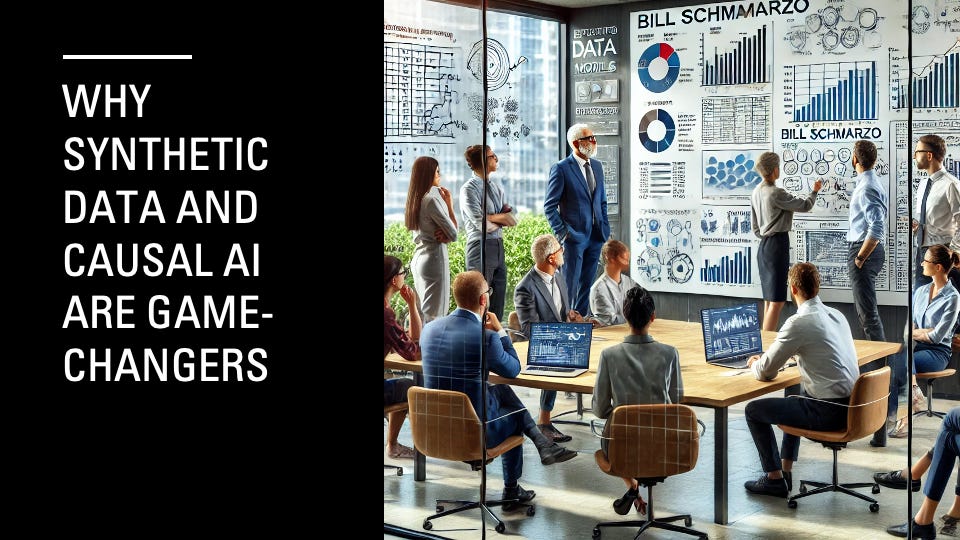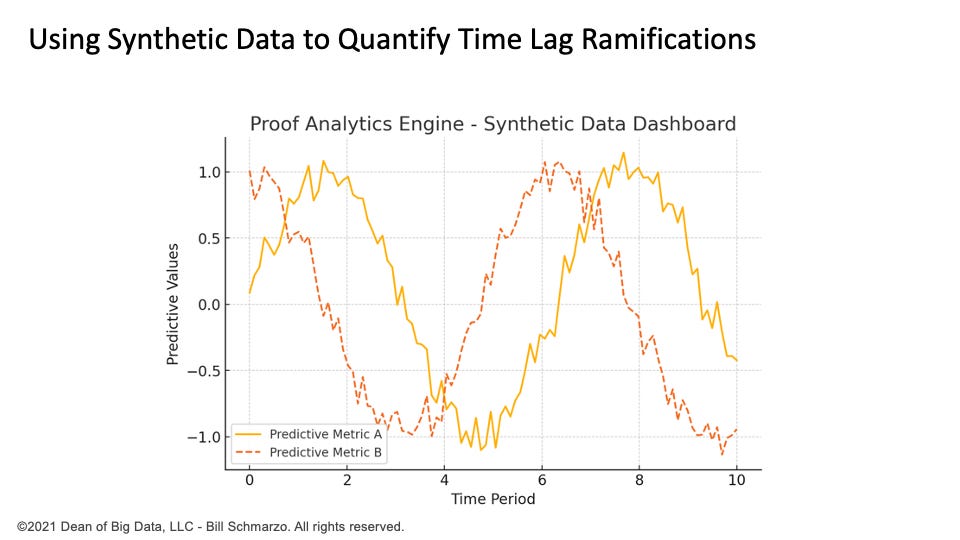Why Synthetic Data and Causal AI Are Game-Changers for Business Decision-Making
By Bill Schmarzo, the Dean of Big Data
I’ve spent my career exploring how organizations can extract real value from data, championing the move from descriptive and diagnostic analytics to predictive and prescriptive analytics. But when I recently saw what ProofAnalytics.ai Analytics.ai is doing with synthetic data in causal models, I had one of those rare, paradigm-shifting moments that left me genuinely excited about what’s next.
Why? Because It Solves One of the Biggest Problems in Business Analytics
For years, businesses have relied on historical data to drive decision-making. But what happens when historical data doesn’t exist, is incomplete, or is riddled with bias? Worse yet, what if the market conditions have changed so much that past data is no longer a reliable predictor of the future?
This is where synthetic data and counterfactual modeling change the game.
ProofAnalytics.ai has developed a system that enables businesses to create realistic, statistically robust synthetic datasets to simulate various market conditions, business strategies, and operational changes before they occur. This allows companies to conduct accurate scenario modeling—testing different decisions and observing their potential impacts—without waiting months or years for real-world data to accumulate.
Synthetic Data in Causal AI: From Correlation to True Causality
One of the biggest mistakes businesses make is assuming correlation equals causation. Traditional machine learning models, even predictive ones, are often just advanced correlation engines. They can tell you what has happened and what might happen again—but not why it happened.
Causal AI, when fueled with high-quality synthetic data, changes that. ProofAnalytics.ai’s approach allows businesses to model different scenarios, isolating variables to understand the true cause-and-effect relationships within their operations. This means decision-makers can stop gambling on intuition and start confidently making data-driven, risk-adjusted decisions.
The Big Shift: From “What Happened” to “What’s Possible”
The traditional analytics approach is retrospective—it looks backward to analyze what happened and then tries to extrapolate insights from past data. However, combining synthetic data and causal modeling allows us to look forward. Instead of asking, “What did our past marketing spend do?” we can ask, “What’s the optimal marketing mix for the next 12 months, given various economic scenarios?” Instead of looking at how a supply chain disruption affected revenue, we can simulate multiple disruptions ahead of time and proactively adjust.
This shift—from descriptive hindsight to counterfactual foresight—makes ProofAnalytics.ai’s work so groundbreaking.
Generative AI as a “Mix-In” for Machine Learning
This innovation involving synthetic data and causal AI aligns perfectly with my vision for the future of Generative AI (GenAI) in traditional machine learning workflows. I’ve always seen GenAI as a “mix-in” rather than a standalone solution—something that enhances existing ML models instead of replacing them entirely.
In predictive maintenance, traditional supervised and unsupervised machine learning algorithms analyze sensor outputs, operational logs, and past failure instances to identify patterns. However, there isn't enough failure data to train an effective model for critical equipment that seldom fails, such as nuclear reactors or aircraft components.
GenAI can generate synthetic failure data, enabling supervised ML models to learn from a broader range of scenarios without waiting for real-world failures to happen. Likewise, GenAI can enhance anomaly detection by introducing synthetic deviations, simulating various operating conditions, and improving feature engineering by revealing complex patterns in data that traditional methods may overlook.
The result? More accurate, more robust, and more adaptable Machine Learning models.
The Role of AI in Democratizing Synthetic Data
Until recently, generating high-quality synthetic data at scale was challenging and required specialized expertise and significant computational resources. However, with the emergence of AI-powered tools like ChatGPT and various generative models, creating synthetic data has become more accessible. These AI tools can generate realistic, statistically sound data that reflects complex business dynamics, making it available to organizations of all sizes—not just those with extensive data science teams.
This accessibility is transformative. AI-driven synthetic data generation empowers companies to simulate and test various business scenarios with minimal friction, eliminating traditional barriers like missing data, bias, and lengthy data collection processes. Consequently, this fosters faster learning, more robust decision-making, and agility in navigating market uncertainties.
Synthetic Data: Addressing the Data Quality Crisis
One of the most overlooked benefits of synthetic data is its ability to mitigate the data quality problem that plagues many companies today. Incomplete, inconsistent, and biased data have long been barriers to effective analytics, often leading to flawed insights and poor decision-making.
Businesses can address missing or unreliable data by incorporating synthetic data into causal AI models, ensuring that decision-making relies on credible, unbiased information. This is particularly valuable when data collection is fragmented or strict privacy regulations restrict access to real-world data. With synthetic data, companies are no longer constrained by poor data hygiene or incomplete records—they can proactively generate high-quality datasets to achieve better outcomes.
Unlocking a New Era of Business Agility
For years, I’ve advocated for organizations to treat data as a strategic asset and to build economic value from their data investments. What ProofAnalytics.ai is doing takes that philosophy to the next level.
Synthetic data eliminates the traditional barriers of missing data, bias, and long feedback loops that have hampered analytics adoption. By integrating it with causal models, businesses are no longer just predicting the future—they are engineering for it.
Final Thought: If You’re Not Thinking About This Yet, You Should Be
This is a huge deal. ProofAnalytics.ai’s approach enables businesses to run what-if experiments with unprecedented rigor and accuracy, empowering leadership teams to optimize strategies before making real-world bets.
And when you layer in the power of Generative AI as a mix-in, the potential to enhance traditional machine learning models expands even further. If you’re a business leader, a data scientist, or anyone responsible for strategic decision-making, this is the kind of technology you need to start integrating—yesterday.
I’m looking forward to experimenting with this more, but I can already tell you: This is the future of data-driven decision-making.


